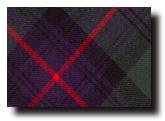
The origins of this powerful Border family are said to go back to a "Siward Digry" (sword strong arm) who was the last Anglo-Danish Earl of Northumberland and a nephew of King Canute, who reigned in the 11th century. The name became widespread in the north of England and the Scottish Borders but their main power base became Liddesdale in the Borders. Gilbert Armstrong was a steward of King David II and in 1363 acted as an ambassador to the English court of King Edward III.
The family grew in strength and could muster 3,000 horsemen and virtually controlled the whole Border region at one stage. This meant that they were in a more or less constant state of conflict with the English lords and earls on the other side of the border with England.
The power of the Armstrongs became a perceived threat to the monarch of Scotland and King James V (who reigned from 1513 to 1542) tricked John Armstrong of Kilnockie into meeting him at Hawick - and promptly hanged him. A few years later, however, the Armstrongs refused to support King James V's invasion of England. It is possible that this made a difference at the Battle of Solway Moss in 1542, which cost King James his life.
The Union of the Crowns in 1603 brought an official end to the cross-border conflicts but old habits died hard. In 1610 the Armstrong laird was hanged for a reiving (cattle rustling) raid on Penrith. The Armstrongs were scattered at that time and there has been no chief of the clan since then. Many Armstrongs moved to Northern Ireland and also around the world.
The most travelled Armstrong has to be Neil Armstrong who was the first man to walk on the moon.
The Armstrong motto is "Invictus maneo" which means "I remain unvanquished".
Surnames regarded as septs (sub-branch) of the Armstrongs include Fairbairn and Nixon.



